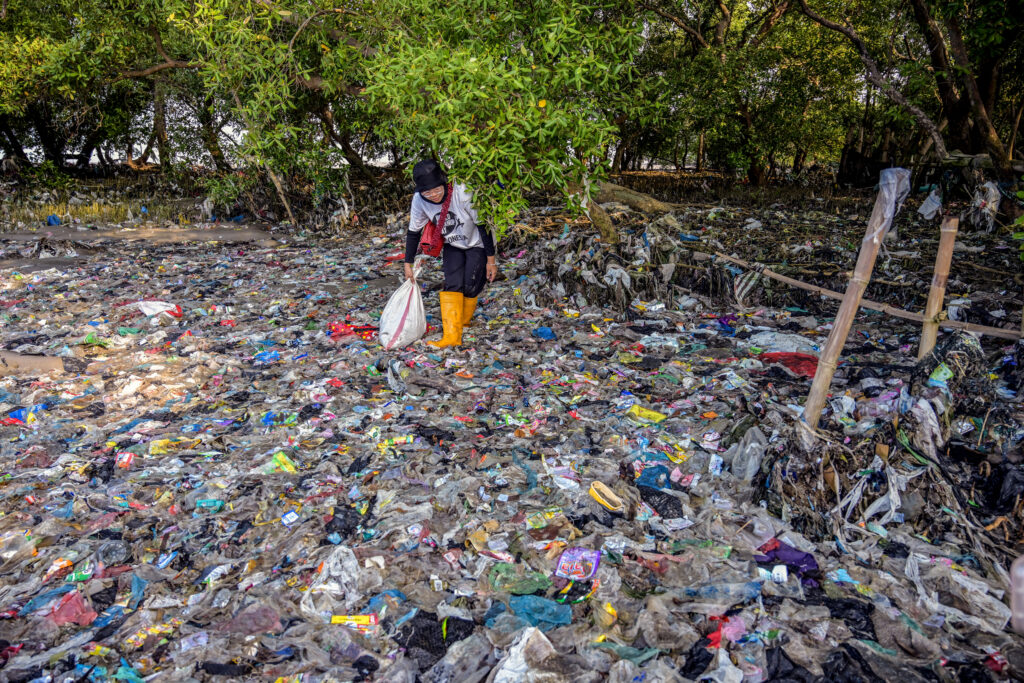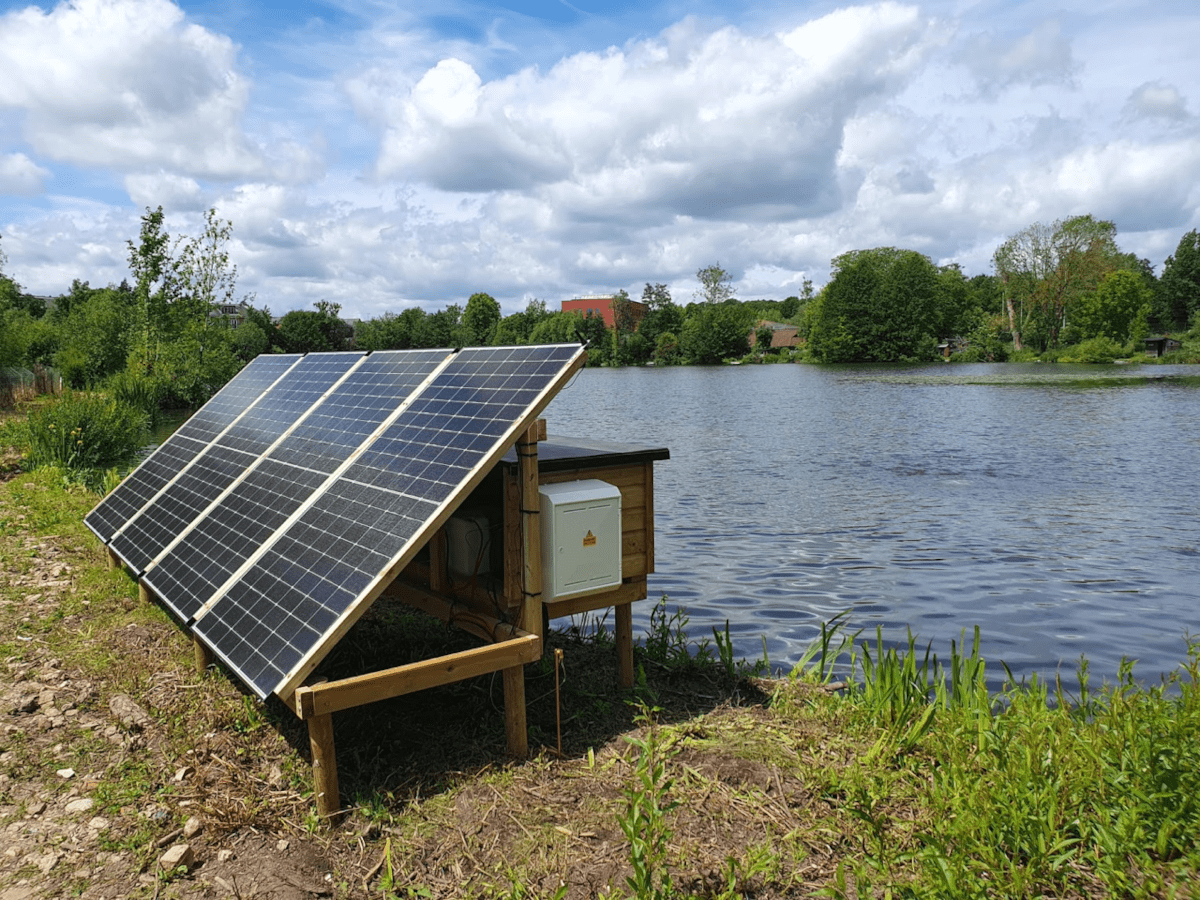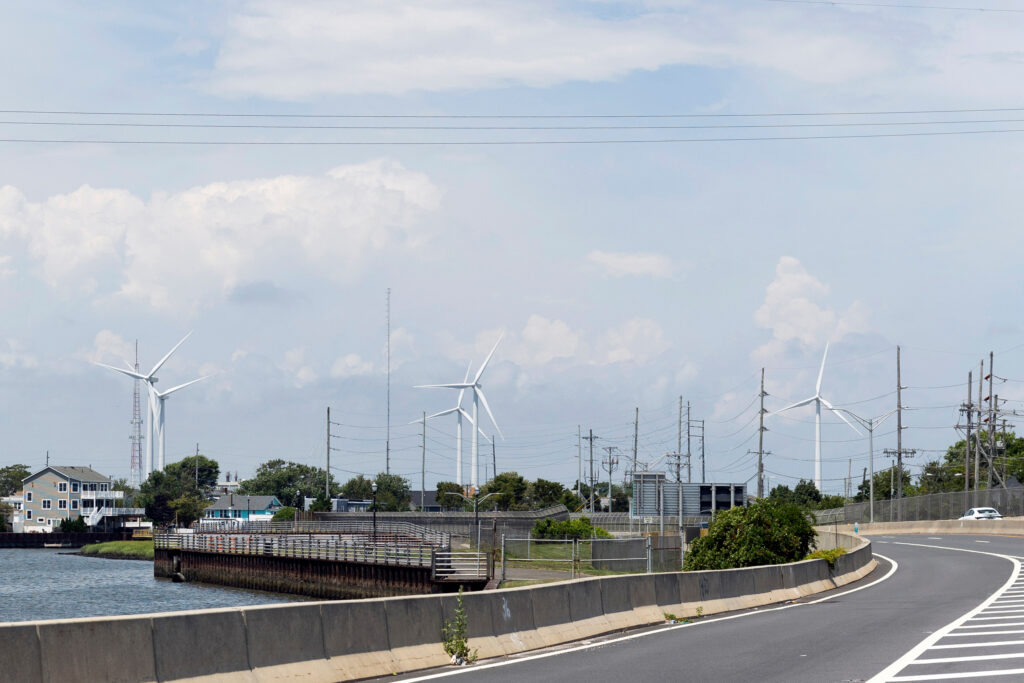RIFLE, Colo.—The vegetation along the Colorado River as it runs next to Interstate 70 is lush in early June, soaking up the tail end of this year’s meager spring runoff as it makes its way West.
But as you approach Rifle, Colorado, splotches of dry grass begin popping up on the slopes above the river’s southern bank. In the second half of the 21st century, oil shale companies began moving into the small town and “bought up the ranches for the water rights,” said Leslie Robinson as she looked out across the river from a well pad near her home. “Oil and gas gets water first,” she said.
Since Robinson, an environmental advocate, moved to Rifle over 50 years ago, she has witnessed the boom and bust of extractive industries on the state’s Western Slope, where they devour local economies and natural resources when times are good, then turn away when prices fall.
“When you live in Rifle, you can’t escape it,” she said. “It’s all about energy.”

The use of freshwater in oil and gas drilling has been the subject of intense scrutiny in Colorado lately amid a deepening, decades-long drought and a forecasted increase in demand from the industry. Oil and gas extraction currently uses less than one percent of the state’s freshwater, but even that amount gets mired in controversy.
This March, Colorado’s Energy and Carbon Management Commission (ECMC), which regulates the oil and gas industry, passed new rules requiring drillers to recycle more of their wastewater—a caustic, brackish and chemically laden byproduct of the drilling and fracking process known as “produced water.” The new rules were set in motion by HB23-1242, passed in 2023, which requires oil and gas extraction companies to use more recycled water, but do not address another key provision of the law: the increased recycling of produced water cannot cause more oil and gas emissions, which can contain CO2, methane, benzene, a known carcinogen, and other volatile organic compounds.
Regulators across the state are trying to figure out whether meeting one requirement of the new law requires violating the other.
A few yards from where Robinson was taking in the Colorado River, Andrew Klooster, a Colorado field advocate with Earthworks, an environmental nonprofit, was pointing what looked like a small movie camera mounted on a tripod at large beige tanks. The two were doing an annual checkup on oil and gas wastewater infrastructure along the Interstate 70 corridor to better understand how it emits gases into the atmosphere.
Oil and gas companies usually accumulate wastewater in pits or large cylindrical tanks before either trucking or piping it to a recycling facility or an injection well that can store it underground. Both recycling the water and storing it underground can produce emissions.
“We know that the produced water waste stream does generate emissions and does generate potentially a lot of emissions,” said Klooster, who has spent years monitoring oil and gas sites in Colorado using an optical gas imaging camera, a machine capable of rendering invisible vapor plumes visible to the human eye.


To increase produced water recycling in Colorado, oil and gas companies will need to store more produced water, which means more pits, tanks, pipelines, trucks and recycling facilities.
“How you do that without creating more of an emissions problem is really, really hard to figure out,” Klooster said, as he and Robinson began what they call their “toxic tour.”
“They haven’t really demonstrated as an industry their ability to even store and transport the produced water without emissions,” he said.
Oil and gas companies are not required to control emissions from produced water in certain scenarios.
As produced water storage tanks or pits sit in the sun, the liquid they hold heats up, building pressure in the container. Over a certain threshold, operators must take steps to destroy these emissions, typically by burning them off in a process called “flaring” that releases less harmful gases into the atmosphere, a practice regulated by the Colorado Department of Public Health and the Environment (CDPHE). But if an operator calculates that a facility releases less than 2 tons of emissions annually, they may vent them freely and do not have to take steps to reduce them.
And to further complicate the tradeoffs involved with controlling both emissions and produced water, as part of HB23-1242, the legislature said that no new centralized produced water facilities may be built in “disproportionately impacted communities”—census blocks where at least 40 percent of households are low income, or areas where multiple factors “affect health and the environment and contribute to persistent disparities.”
This definition includes areas of Colorado’s Western Slope, like Rifle, and parts of the Front Range on the other side of the Rocky Mountains, where communities living with a boom in oil and gas drilling are saddled with unhealthy air and are grappling with similar concerns to those found farther west.
“I still currently, if I’m being honest, struggle with what causes less harm,” said Harmony Cummings, the director of the Green House Connection Center, an environmental nonprofit in Denver. “This is what the industry keeps saying back to us: Do you want to have thousands of [truck] trips? Or do you want to have a treatment facility?” Given the poor air quality in the front range, oil and gas companies may struggle to build new produced water storage facilities there, she added.
Oil and gas companies have argued that building more produced water recycling infrastructure will help them avoid emissions. But without an exemption to the prohibition on produced water facilities being built in communities already disproportionately impacted by economic and environmental hardships, Western Slope companies say they will be forced to use more emissions-intensive truck trips to increase produced water recycling elsewhere.
“Storage tanks with controls and pipelines make a difference in lowering air emissions from produced water,” particularly by lowering a company’s reliance on truck trips, said Kristine Mize-Spanksy, an integrity management & GIS supervisor at QB Energy, in a statement to Inside Climate News. “Well-designed and properly managed produced water handling and storage systems can significantly increase recycling rates with negligible impact on air emissions.”
Klooster and Robinson appreciate Colorado’s desire to limit pollution, and the two are heartened when an operator takes steps to mitigate emissions they have spotted. Nonetheless, they worry the state has drawn up a set of regulations that could be impossible to implement without either increasing emissions, or saddling some communities with more produced water recycling infrastructure—or both.
“I don’t want them to drill any more of these or to develop any more of these processing plants in [disproportionately impacted communities]…which includes this whole valley. And it’s not just impacting people, but water and animals and the environment,” Robinson said. “There’s going to be leaks.”
Living Alongside Extractive Industries
Robinson came to Rifle in 1975 to work in the nearby outdoor economies of Glenwood and Aspen, then fell in love with the area and decided to build a life here. She held a marketing job with a local media company and worked for the U.S. Census Bureau before retiring in 2008 and becoming head of the Grand Valley Citizen Alliance, an environmental activist organization.
Today, Robinson’s sandy gray hair frames engaging, playful eyes. She has a quick sense of humor about monitoring oil and gas infrastructure in a community with an economy dependent on the fossil fuel industry.
“I don’t think oil and gas worries about me [and Klooster] running around [with a camera],” she said. “But we’re mosquitoes, and it makes the bear stop and swat.”
As Colorado regulators drafted rules for produced water recycling, Grand Valley Citizen Alliance and other environmental groups advocated for regulations to prevent produced water being exchanged between basins. Recycled produced water in the Piceance basin, the oil and gas formation where Rifle is located, accounted for 92.26 percent of the water used to frack new wells there in 2022. That figure was only 0.4 percent for Front Range producers, according to a state report, because those companies do not have a robust recycling network and tended to use freshwater to drill. Environmentalists were concerned that the difference could create a market for companies to send water from the Western Slope to producers in the eastern plains of the state.
“We were able to accomplish that,” Robinson said of new regulations preventing water sharing between basins. “Not much more.”


Robinson delivered that assessment from a county road about 10 minutes from her home, at a gas well owned by Terra Energy Partners, which is doing business in Colorado as TEP Rocky Mountain. The well pad backdropped by the hulking tan cliffs of the Roan Plateau was the first stop on her tour with Klooster, who aimed his camera at the tanks as Robinson spoke.
He was pretty sure he could see emissions coming off the hatches on one of TEP’s storage tanks—one he and Roobinson had filed a complaint about before—but due to the direction of the wind and his proximity to the vent (Klooster is oftentimes confined to public roads when making his assessments), he was having difficulty rendering a clear image.
Klooster’s camera, which he estimates costs about $100,000 to purchase and learn to use, cannot differentiate between any of the compounds in the vapor it visualizes. Nor can it quantify the volume of the gas it picks up. Instead, Klooster’s camera can offer residents, environmental organizations and regulators evidence to show a company whether their equipment is functioning properly.
To get an air permit under Colorado law, operators perform calculations on the potential emissions from a piece of equipment or site. They can use CDPHE equations, or develop their own using CDPHE-approved sampling methods. If companies forecast that equipment or facilities will release less than two tons of volatile organic compounds annually, they aren’t required to control those emissions.
Klooster was eventually able to make a clearer picture of the emissions, and later filed a complaint with the CDPHE’s Air Pollution Control Division (APCD). In two previous complaints, filed by Robinson in August and September of 2024, the company told regulators that the hatches were either dirty or being repaired at the time of Klooster’s videos. In both cases, TEP told the state it had applied a fix and reevaluated the facility with an OGI camera, and the emissions had stopped.
But this time in response to Klooser’s footage, an APCD employee emailed to tell him that TEP had a permit for uncontrolled emissions from that facility, and the equipment was working as designed. “There is no way for me to require them to make any repairs in response to observed emissions,” the employee wrote.
APCD later informed Klooster that the facility “became not subject to [leak detection and repair] and tank control requirements between 2023 and 2024,” signaling to Klooster that the company had calculated its emissions from the site to be under two tons per year.
“Operators are trying to convince the public that they are doing everything they can to control emissions. The reality is they are doing everything they are required to do, and in this case, they are claiming they are not required to do anything.”
— Andrew Klooster, Earthworks
Klooster has also filmed emissions coming off TEP pipeline infrastructure elsewhere on the Western Slope.
TEP did not return multiple requests for comment.
Mize-Spansky, a supervisor at QB Energy, said that “gas leaks, blowdowns or other releases from produced water pipelines are rare.”
Klooster worries that the current permitting system makes it more difficult to accurately assess emissions from produced water facilities and leaves operators little incentive to do so.
“If you are supposedly not emitting enough to control emissions but you are also exempt from being forced to address leaks, why should we have faith that you are actually emitting below the [two tons per year] threshold?” he wrote in an email to Inside Climate News. “Operators are trying to convince the public that they are doing everything they can to control emissions. The reality is they are doing everything they are required to do, and in this case, they are claiming they are not required to do anything.”
“CDPHE is working in conjunction with the Colorado Produced Water Consortium to further research the emissions generated by the recycling of produced water,” said Leah Schleifer, a communications and outreach specialist with CDPHE, in an emailed response to questions about whether the agency was considering amending its air permitting process in light of Colorado’s push to limit produced water emissions. “These efforts are ongoing.”
More Pipes or More Trucks?
In a drab white conference room back in Rifle, members of the Colorado Produced Water Consortium, a body of 31 people including regulators, industry representatives, environmentalists and scientists, gathered two days after Robinson and Klooster’s toxic tour to learn about the intersection of produced water infrastructure and communities already disproportionately impacted by environmental and economic challenges.
Earlier that day, the group had gone on a tour of infrastructure led by Western Slope producers. Klooster and Robinson were not on the tour, but they came to the conference room to submit comments alongside county officials and representatives from Western Slope oil and gas companies, including Mize-Spansky.
In their presentation to the consortium, oil and gas company representatives said that their network of tanks, pipes and pits on the Western Slope grew out of consultation with communities that requested a decrease in truck traffic decades ago, and helps reduce emissions. The approach is also driven by costs and “doing the right thing,” Mize-Spansky said.


If companies could no longer build produced water recycling infrastructure near new well pads on the Western Slope they would revert to using more trucks. Mize-Spansky estimated one truck would make over 3,000 trips just to prepare one well for production. “Think of the emissions and driving safety risks from all those trucks,” she said.
But with gas prices low, Robinson and others have wondered how much more drilling will happen in the basin.
In her statement to Inside Climate News, Mize-Spansky noted that truck trips are still effective “when the resource needs to move in small quantities, infrequently or in remote areas.”
“We’ve got twenty years of history out here recycling. We want to continue to do that,” Mize-Spansky said. “We’re very concerned that the prohibition [on new centralized produced water recycling facilities in disproportionately impacted communities] is going to push us to change our operations.”
Emissions from trucks carrying produced water may be greater than those that escape from tanks and pipelines.
“The more you keep [produced water] closed up and under some pressure, the better off you are,” said Seth Lyman, an environmental scientist at Utah State University who studies emissions from produced water ponds in Utah’s Uinta Basin. Lyman noted that there has been less research quantifying emissions from produced water sitting in a storage tank or moving through a pipeline, but he still felt that installing more of that infrastructure would lead to an increase in emissions.
“Any oil and gas operation is going to have some emissions, and so you can expect that any increase in operations will increase emissions to some extent,” he said.
This story is funded by readers like you.
Our nonprofit newsroom provides award-winning climate coverage free of charge and advertising. We rely on donations from readers like you to keep going. Please donate now to support our work.
Donate Now
During the meeting, Klooster gave a presentation about his concerns with produced water storage tanks and pipelines using videos he had made surveilling TEP infrastructure.
Shawn Brennan, an environmental manager at TEP, said that the company makes monthly trips to sites to monitor equipment, and that TEP fixed some of the leaks shown in Klooster’s videos. “Some things change, seals fail. It’s why we go as frequently as we do,” he said. “We’re not perfect, but we’re doing our best to minimize fugitive emissions.”
Regulatory Beginnings
The Produced Water Consortium met again in August to discuss draft recommendations to the ECMC about how the state could responsibly site produced water recycling facilities in disproportionately impacted communities.
They tentatively planned to recommend allowing new produced water recycling infrastructure in disproportionately impacted communities only if “enhanced protections” were implemented for the community. The recommended protections included increasing setback distances for new facilities, requiring companies to submit an alternative site, mandating enhanced emissions capture and control, prioritizing pipelines to reduce truck trips and engaging with communities and local governments earlier in the siting process.
Robinson was dismayed. “We’re dissatisfied that there would be any discussion of produced water facilities in disproportionately impacted communities,” she said. While Robinson said Grand Valley Citizen Alliance has not figured out what to do next, she does expect this issue to be before the legislature next year. “I think the battle lines are already being drawn politically,” she said.


The rules have not been officially approved by the consortium, and ECMC commissioner John Messner did not rule out future legislation to address the issue, either. “This is not the only bite at the apple,” he said.
Regulators elsewhere in the state say they have only just started deliberating the issue. Trisha Oeth, an ECMC commissioner and chair of the Produced Water Emissions Workgroup, said determining a baseline for emissions and whether and how emissions could change as a result of increased produced water recycling was the group’s first task.
“We in this working group are taking this one step at a time, really trying to get a good understanding of what is happening with the operations, what would change and what does that look like for air emissions?” she said.
Oeth hopes to have recommendations for the ECMC ready by the start of 2026, when operators must begin meeting produced water recycling thresholds, and added that, depending on what the working group finds, they may not need new rules. Her group would not have the power to change how CDPHE regulates air permits for oil and gas facilities, she said, and Oeth declined to speak about what might happen if Colorado determines it cannot keep emissions from rising along with produced water recycling rates, as the law requires.
Produced Water Emissions Workgroup meetings are not open to the public.
“It is kind of a lose-lose situation,” Klooster said. “This whole premise is really just a means to help continue to develop new wells in Colorado, but just not use as much freshwater while doing it.”
Robinson likened Colorado’s effort to balance oil and gas fresh water consumption and community concerns alongside efforts to limit emissions to a test. “There’s not a good answer. I mean it’d be C, none of the above, you know? Forget about the whole oil and gas industry.” If a similar level of regulatory willpower and private-sector dollars were put elsewhere in the economy, particularly into clean energy, “imagine how far we’d be,” she said.
The Lee fire raging nearby had eclipsed 100,000 acres by Aug. 11, but Robinson was preparing that day for a county commissioner meeting on permits for 39 new TEP wells about five miles from the home that she might have to evacuate.
“The oil and gas situation across the board just never ends,” she said.
About This Story
Perhaps you noticed: This story, like all the news we publish, is free to read. That’s because Inside Climate News is a 501c3 nonprofit organization. We do not charge a subscription fee, lock our news behind a paywall, or clutter our website with ads. We make our news on climate and the environment freely available to you and anyone who wants it.
That’s not all. We also share our news for free with scores of other media organizations around the country. Many of them can’t afford to do environmental journalism of their own. We’ve built bureaus from coast to coast to report local stories, collaborate with local newsrooms and co-publish articles so that this vital work is shared as widely as possible.
Two of us launched ICN in 2007. Six years later we earned a Pulitzer Prize for National Reporting, and now we run the oldest and largest dedicated climate newsroom in the nation. We tell the story in all its complexity. We hold polluters accountable. We expose environmental injustice. We debunk misinformation. We scrutinize solutions and inspire action.
Donations from readers like you fund every aspect of what we do. If you don’t already, will you support our ongoing work, our reporting on the biggest crisis facing our planet, and help us reach even more readers in more places?
Please take a moment to make a tax-deductible donation. Every one of them makes a difference.
Thank you,


















